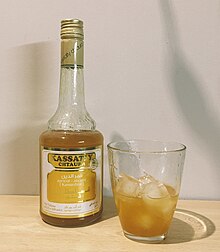Qamar al-din
 | |||||||
| Alternative names | Qamaruddin | ||||||
|---|---|---|---|---|---|---|---|
| Type | Drink | ||||||
| Place of origin | Syria[1] | ||||||
| Region or state | Ghouta | ||||||
| Associated cuisine | Levantine | ||||||
| Serving temperature | Cold | ||||||
| Main ingredients | Apricots | ||||||
| Ingredients generally used | Orange blossom water, sugar | ||||||
| 38 kcal (159 kJ)[2] | |||||||
| |||||||
Qamar al-Din[fn 1] (Arabic: قمر الدين, lit. 'Moon of the Faith') is an apricot fruit leather, which is popularly made into apricot juice or nectar beverage from Arab cuisine that is famously consumed during the Muslim holy month of Ramadan. It originates from Syria[3] and was first produced in the Ghouta, where the variety of apricots most suitable for qamar al-din was first grown. Qamar al-din is enjoyed across the Middle East and North Africa as well as in Somalia, though Syrian qamar al-din is still believed to be the best because the variety of apricots most suitable for making qamar al-din grow only in Syria and southwestern Turkey.[3][4][5]
Etymology
Several theories have been proposed for the origin of qamar al-din's name. One theory holds that it was named for its inventor, a Syrian man named Qamar al-Din. He was said to have been so handsome that he resembled the moon (qamar, Arabic: قمر), hence his name.[3]
Another theory holds that apricot season coincided with the sighting of the new moon marking the beginning of Ramadan in the year when qamar al-din was invented.[3] A similar theory, widespread in Egypt, traces the name's origin to a Caliph who was known to celebrate with qamar al-din upon seeing the crescent moon during Ramadan.[4]
Method of preparation

To produce Qamar al-din, apricots and sugar are boiled over a fire and then strained through a wooden strainer that is soaked in olive oil. The apricots are then left to dry in direct sunlight. Once it has completely dried, it is then packaged, shipped, and sold. This dried apricot leather is thicker, more consistent, and has a stronger flavor than ordinary apricot leather, and is thus more suitable for making qamar al-din.[5] Making the drink from this apricot leather only requires adding rosewater or orange blossom water, though apricot pieces (fresh or dried) and ice are often added as well. Sometimes, some of the floral water is replaced with orange juice or plain water.[3] Qamar al-din is traditionally served thick and cold, and it is believed to be especially fortifying and a good source of energy, electrolytes, and hydration, all of which are crucial after a day of fasting.[6][5] Some in the Levant add pine nuts and ice to their qamar al-din, making a beverage that resembles a thicker, apricot-flavored version of jallab.[7] In Syria, it is also casually eaten without being turned into a drink, as the fruit roll to snack on itself. A common variation is wrapping the fruit leather around a piece of walnut.
Notes
- ^ Also transliterated Qamar al-Deen, Qamar ad-Din/ad-Deen, Qamar Eddine, Qamaruddin, Kamaruddin, Amardine, and a myriad of other ways. Transliteration of Arabic is notoriously fraught with challenges, even before differences between Arabic's many dialects are taken into account.
References
- ^ "Qamar al-Din, a unique Syrian product with high nutritional and medical value". SANA. 14 June 2021.
- ^ "قمر الدين" [Qamar Al-Din]. كوكباد (in Arabic). Cookpad Inc. Retrieved 22 May 2018.
- ^ a b c d e Xawaash, Leila; Xawaash, Abdullahi (9 June 2014). "Qamar al-Din (Qamaraddiin) قمر الدين". Xawaash.com. Retrieved 22 May 2018.
- ^ a b Robertson, Amy (8 June 2017). "All Over The World, Thirsty Muslims Have Their Ramadan Go-To Drinks". NPR. Retrieved 22 May 2018.
- ^ a b c Denker, Joel (14 June 2016). "'Moon Of The Faith:' A History Of The Apricot And Its Many Pleasures". NPR. Retrieved 22 May 2018.
- ^ Amira (22 April 2017). "Qamar Al-Deen (Apricot Juice); Famous Middle Eastern Drink". Amira's Pantry. Retrieved 22 May 2018.
- ^ نانا (4 October 2006). "3 طرق مختلفة لعمل مشروب قمرالدين" [3 different ways to make Qamaruddin]. Arabic Cooking (الطبخ العربي) (in Arabic).